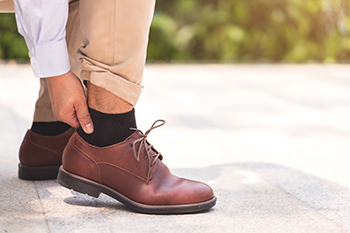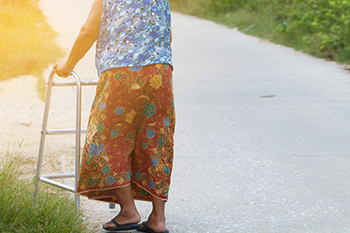
The joint where the big toe connects to the foot is called the hallux. When this joint becomes stiff, it not only limits the ability to walk but also can become quite painful. This condition, termed hallux limitus, can result in arthritis and bone spurs. A callus may develop under the toe joint, and numbness and tingling may occur if nerves touch the bone spurs. Other symptoms of hallux limitus can include pain in the toe joint that worsens when you walk or flex the toe, and limping may result. Hallux limitus is thought to be caused predominantly by wear and tear in the joint. In some cases, abnormal foot structure, such as when the second toe is longer than the big toe, can possibly cause this condition. Wearing high heels that add pressure to the big toe joint is another potential reason hallux limitus can develop. A podiatrist can examine the toe joint with an X-ray to determine the extent of the condition. In some cases, custom orthotics can be prescribed to help correct the condition. If your big toe joint causes pain, especially while walking, it is suggested that you make an appointment with a podiatrist.
Toe pain can disrupt your daily activities. If you have any concerns, contact one of our podiatrists of InStride Family Foot Care. Our doctors can provide the care you need to keep you pain-free and on your feet.
What Causes Toe Pain?
Most severe toe pain is caused due to a sports injury, trauma from dropping something heavy on the toe, or bumping into something rigid. Other problems can develop over time for various reasons.
Toe pain can be caused by one or more ailments. The most common include:
- Trauma
- Sports injury
- Wearing shoes that are too tight
- Arthritis
- Gout
- Corns and calluses
- Hammertoe
- Bunions
- Blisters
- Ingrown toenails
- Sprains
- Fractures (broken bones)
- Dislocations
When to See a Podiatrist
- Severe pain
- Persistent pain that lasts more than a week
- Signs of infection
- Continued swelling
- Pain that prevents walking
Diagnosis
In many cases the cause of toe pain is obvious, but in others, a podiatrist may want to use more advanced methods to determine the problem. These can range from simple visual inspections and sensation tests to X-rays and MRI scans. Prior medical history, family medical history, and any recent physical traumatic events will all be taken into consideration for a proper diagnosis.
Treatment
Treatments for toe pain and injuries vary and may include shoe inserts, padding, taping, medicines, injections, and in some cases, surgery. If you believe that you have broken a toe, please see a podiatrist as soon as possible.
If you have any questions please feel free to contact our offices located in Concord, Charlotte, and Salisbury, NC . We offer the newest diagnostic tools and technology to treat your foot and ankle needs.









